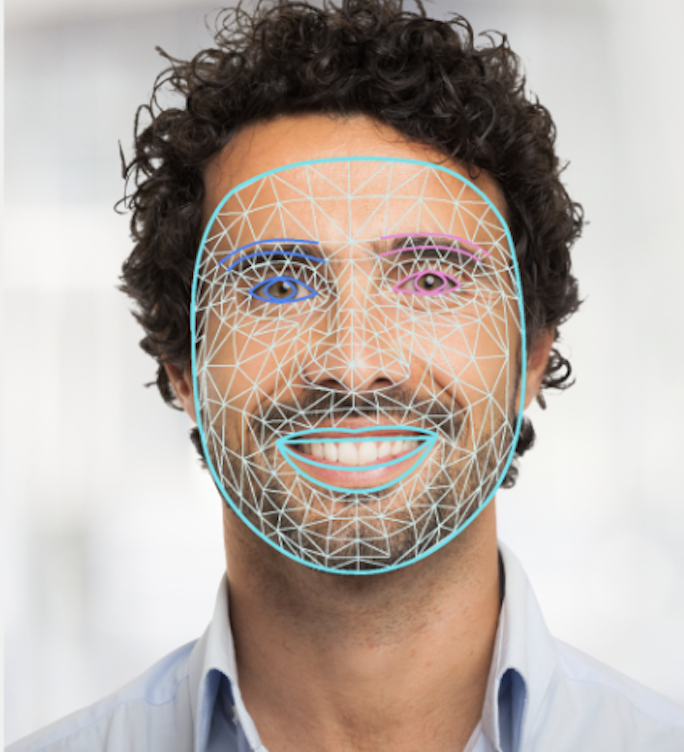MediaPipe Face Landmarker 工作可讓您在圖片和影片中偵測臉部特徵和表情。您可以使用這項工作來辨識人類的面部表情,並套用臉部濾鏡和效果,建立虛擬人物。這項工作會使用機器學習 (ML) 模型,可處理單張圖片或連續圖片串流。這項工作會輸出 3D 臉部地標、混合形狀分數 (代表臉部表情的係數),以便即時推斷臉部表面的詳細資料,以及轉換矩陣,執行特效算繪所需的轉換作業。
您可以在 GitHub 上找到這些操作說明中所述的程式碼範例。如要進一步瞭解這項工作的功能、模型和設定選項,請參閱總覽。
程式碼範例
臉部標記辨識器的範例程式碼會在 Python 中提供此任務的完整實作方式,供您參考。這段程式碼可協助您測試這項工作,並開始建構自己的臉部標記。您只需使用網頁瀏覽器,即可查看、執行及編輯 人臉標記範例程式碼。
如果您要為 Raspberry Pi 實作人臉標記功能,請參閱 Raspberry Pi 範例應用程式。
設定
本節將說明設定開發環境和程式碼專案的關鍵步驟,以便使用 Face Landmarker。如要進一步瞭解如何設定開發環境以使用 MediaPipe 工作,包括平台版本需求,請參閱 Python 設定指南。
套件
MediaPipe 臉部標記工作需要 mediapipe PyPI 套件。您可以透過下列方式安裝及匯入這些依附元件:
$ python -m pip install mediapipe
匯入
匯入下列類別,即可存取臉部標記器工作函式:
import mediapipe as mp
from mediapipe.tasks import python
from mediapipe.tasks.python import vision
型號
MediaPipe 臉部標記工作需要與此工作相容的訓練模型。如要進一步瞭解 Face Landmarker 可用的訓練模型,請參閱工作總覽的「模型」一節。
選取並下載模型,然後將其儲存在本機目錄中:
model_path = '/absolute/path/to/face_landmarker.task'
使用 BaseOptions 物件 model_asset_path 參數指定要使用的模型路徑。如需程式碼範例,請參閱下一節。
建立工作
MediaPipe 臉部標記器工作會使用 create_from_options 函式設定工作。create_from_options 函式會接受設定選項的值,以便處理。如要進一步瞭解設定選項,請參閱「設定選項」。
以下程式碼示範如何建構及設定此工作。
這些範例也說明瞭圖片、影片檔案和直播的任務建構變化。
圖片
import mediapipe as mp BaseOptions = mp.tasks.BaseOptions FaceLandmarker = mp.tasks.vision.FaceLandmarker FaceLandmarkerOptions = mp.tasks.vision.FaceLandmarkerOptions VisionRunningMode = mp.tasks.vision.RunningMode options = FaceLandmarkerOptions( base_options=BaseOptions(model_asset_path=model_path), running_mode=VisionRunningMode.IMAGE) with FaceLandmarker.create_from_options(options) as landmarker: # The landmarker is initialized. Use it here. # ...
影片
import mediapipe as mp BaseOptions = mp.tasks.BaseOptions FaceLandmarker = mp.tasks.vision.FaceLandmarker FaceLandmarkerOptions = mp.tasks.vision.FaceLandmarkerOptions VisionRunningMode = mp.tasks.vision.RunningMode # Create a face landmarker instance with the video mode: options = FaceLandmarkerOptions( base_options=BaseOptions(model_asset_path=model_path), running_mode=VisionRunningMode.VIDEO) with FaceLandmarker.create_from_options(options) as landmarker: # The landmarker is initialized. Use it here. # ...
直播
import mediapipe as mp BaseOptions = mp.tasks.BaseOptions FaceLandmarker = mp.tasks.vision.FaceLandmarker FaceLandmarkerOptions = mp.tasks.vision.FaceLandmarkerOptions FaceLandmarkerResult = mp.tasks.vision.FaceLandmarkerResult VisionRunningMode = mp.tasks.vision.RunningMode # Create a face landmarker instance with the live stream mode: def print_result(result: FaceLandmarkerResult, output_image: mp.Image, timestamp_ms: int): print('face landmarker result: {}'.format(result)) options = FaceLandmarkerOptions( base_options=BaseOptions(model_asset_path=model_path), running_mode=VisionRunningMode.LIVE_STREAM, result_callback=print_result) with FaceLandmarker.create_from_options(options) as landmarker: # The landmarker is initialized. Use it here. # ...
如需建立臉部標記以供圖片使用,請參閱完整範例程式碼範例。
設定選項
此工作包含下列 Python 應用程式的設定選項:
| 選項名稱 | 說明 | 值範圍 | 預設值 |
|---|---|---|---|
running_mode |
設定工作執行模式。共有三種模式: IMAGE:單一圖片輸入模式。 VIDEO:影片解碼影格模式。 LIVE_STREAM:輸入資料 (例如來自攝影機的資料) 的直播模式。在這個模式中,必須呼叫 resultListener,才能設定事件監聽器,以非同步方式接收結果。 |
{IMAGE, VIDEO, LIVE_STREAM} |
IMAGE |
num_faces |
FaceLandmarker 可偵測的臉孔數量上限。只有在 num_faces 設為 1 時才會套用平滑處理。 |
Integer > 0 |
1 |
min_face_detection_confidence |
系統判定臉部偵測成功的最低可信度分數。 | Float [0.0,1.0] |
0.5 |
min_face_presence_confidence |
臉部特徵偵測中臉部存在分數的最低可信度分數。 | Float [0.0,1.0] |
0.5 |
min_tracking_confidence |
系統判定臉部追蹤成功的最低可信度分數。 | Float [0.0,1.0] |
0.5 |
output_face_blendshapes |
臉部特徵點偵測器是否會輸出臉部混合形狀。臉部混合形狀用於算繪 3D 臉部模型。 | Boolean |
False |
output_facial_transformation_matrixes |
FaceLandmarker 是否會輸出臉部轉換矩陣。FaceLandmarker 會使用矩陣,將臉部標記從標準臉部模型轉換為偵測到的臉部,方便使用者在偵測到的標記上套用效果。 | Boolean |
False |
result_callback |
在 FaceLandmarker 處於即時串流模式時,將結果事件監聽器設為以非同步方式接收地標結果。只有在執行模式設為 LIVE_STREAM 時,才能使用 |
ResultListener |
N/A |
準備資料
將輸入內容設為圖片檔案或 Numpy 陣列,然後轉換為 mediapipe.Image 物件。如果輸入內容是網路攝影機的影片檔案或直播內容,您可以使用 OpenCV 等外部程式庫,將輸入影格載入為 NumPy 陣列。
圖片
import mediapipe as mp # Load the input image from an image file. mp_image = mp.Image.create_from_file('/path/to/image') # Load the input image from a numpy array. mp_image = mp.Image(image_format=mp.ImageFormat.SRGB, data=numpy_image)
影片
import mediapipe as mp # Use OpenCV’s VideoCapture to load the input video. # Load the frame rate of the video using OpenCV’s CV_CAP_PROP_FPS # You’ll need it to calculate the timestamp for each frame. # Loop through each frame in the video using VideoCapture#read() # Convert the frame received from OpenCV to a MediaPipe’s Image object. mp_image = mp.Image(image_format=mp.ImageFormat.SRGB, data=numpy_frame_from_opencv)
直播
import mediapipe as mp # Use OpenCV’s VideoCapture to start capturing from the webcam. # Create a loop to read the latest frame from the camera using VideoCapture#read() # Convert the frame received from OpenCV to a MediaPipe’s Image object. mp_image = mp.Image(image_format=mp.ImageFormat.SRGB, data=numpy_frame_from_opencv)
執行工作
Face Landmarker 會使用 detect、detect_for_video 和 detect_async 函式觸發推論。對於臉部地標,這包括預先處理輸入資料,以及偵測圖片中的臉部。
以下程式碼示範如何使用工作模型執行處理作業。
圖片
# Perform face landmarking on the provided single image. # The face landmarker must be created with the image mode. face_landmarker_result = landmarker.detect(mp_image)
影片
# Perform face landmarking on the provided single image. # The face landmarker must be created with the video mode. face_landmarker_result = landmarker.detect_for_video(mp_image, frame_timestamp_ms)
直播
# Send live image data to perform face landmarking. # The results are accessible via the `result_callback` provided in # the `FaceLandmarkerOptions` object. # The face landmarker must be created with the live stream mode. landmarker.detect_async(mp_image, frame_timestamp_ms)
注意事項:
- 在影片模式或直播模式下執行時,請一併提供 Face Landmarker 工作單元輸入影格時間戳記。
- 在圖片或影片模型中執行時,Face Landmarker 工作會阻斷目前執行緒,直到處理完輸入圖片或影格為止。
- 在直播模式下執行時,臉部地標器工作會立即傳回,且不會封鎖目前的執行緒。每次處理完輸入影格時,它都會使用偵測結果叫用結果事件監聽器。如果在 Face Landmarker 工作忙於處理另一個影格時呼叫偵測函式,工作會忽略新的輸入影格。
如需在圖片上執行 Face Landmarker 的完整範例,請參閱程式碼範例。
處理及顯示結果
Face Landmarker 會為每次偵測作業傳回 FaceLandmarkerResult 物件。結果物件包含每個偵測到的臉孔的臉部網格,以及每個臉部地標的座標。視需要,結果物件也可以包含代表臉部表情的混合形狀,以及臉部轉換矩陣,以便在偵測到的地標上套用臉部效果。
以下是這項工作的輸出資料範例:
FaceLandmarkerResult:
face_landmarks:
NormalizedLandmark #0:
x: 0.5971359014511108
y: 0.485361784696579
z: -0.038440968841314316
NormalizedLandmark #1:
x: 0.3302789330482483
y: 0.29289937019348145
z: -0.09489090740680695
... (478 landmarks for each face)
face_blendshapes:
browDownLeft: 0.8296722769737244
browDownRight: 0.8096957206726074
browInnerUp: 0.00035583582939580083
browOuterUpLeft: 0.00035752105759456754
... (52 blendshapes for each face)
facial_transformation_matrixes:
[9.99158978e-01, -1.23036895e-02, 3.91213447e-02, -3.70770246e-01]
[1.66496094e-02, 9.93480563e-01, -1.12779640e-01, 2.27719707e+01]
...
下圖是工作輸出內容的視覺化呈現:

臉部地標程式碼範例說明如何顯示工作傳回的結果,詳情請參閱程式碼範例。

